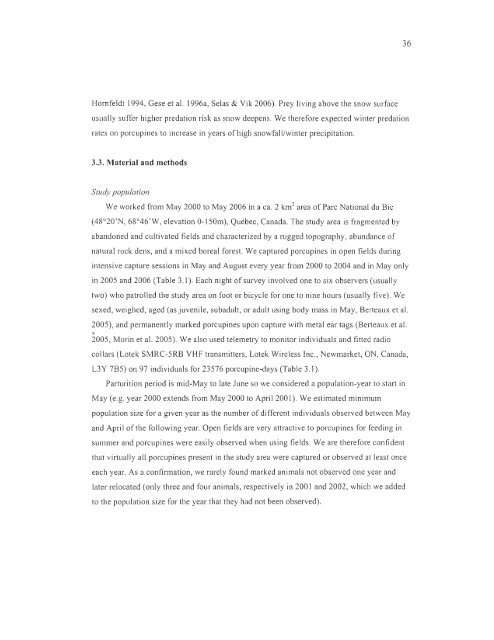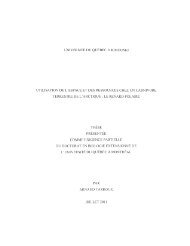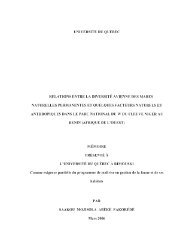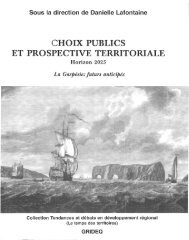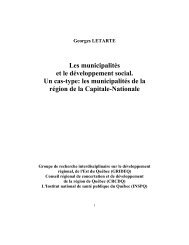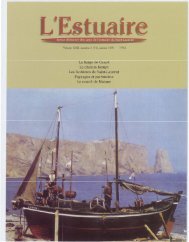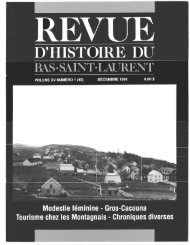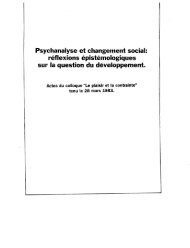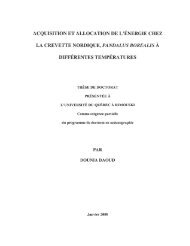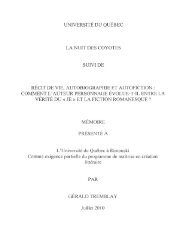influence du climat et de la prédation sur l'utilisation de l'habitat et la ...
influence du climat et de la prédation sur l'utilisation de l'habitat et la ...
influence du climat et de la prédation sur l'utilisation de l'habitat et la ...
You also want an ePaper? Increase the reach of your titles
YUMPU automatically turns print PDFs into web optimized ePapers that Google loves.
36<br />
Hornfeldt 1994, Gese <strong>et</strong> al. 1996a, Se<strong>la</strong>s & Vik 2006). Prey living above the snow <strong>sur</strong>face<br />
usually suffer higher predation risk as snow <strong>de</strong>epens. We therefore expected winter predation<br />
rates on porcupines to increase in years of high snowfall/winter precipitation.<br />
3.3. Material and m<strong>et</strong>hods<br />
Study popu<strong>la</strong>tion<br />
We worked from May 2000 to May 2006 in a ca. 2 km 2 area of Parc National <strong>du</strong> Bic<br />
(48°20'N, 68°46'W, elevation 0-150m), Québec, Canada. The study area is fragmented by<br />
abandoned and cultivated fields and characterized by a rugged topography, abundance of<br />
natural rock <strong>de</strong>ns, and a mixed boreal forest. We captured porcupines in open fields <strong>du</strong>ring<br />
intensive capture sessions in May and August every year from 2000 to 2004 and in May only<br />
in 2005 and 2006 (Table 3.1). Each night of<strong>sur</strong>vey involved one to six observers (usually<br />
two) who patrolled the study area on foot or bicycle for one to nine hours (usually five). We<br />
sexed, weighed, aged (as juvenile, suba<strong>du</strong>lt, or a<strong>du</strong>lt using body mass in May, Berteaux <strong>et</strong> al.<br />
2005), and permanently marked porcupines upon capture with m<strong>et</strong>al ear tags (Be11eaux <strong>et</strong> al.<br />
•<br />
2005, Morin <strong>et</strong> al. 2005). We also used telem<strong>et</strong>ry to monitor indivi<strong>du</strong>als and fitted radio<br />
col<strong>la</strong>rs (Lotek SMRC-5RB VHF transmitters, Lotek Wireless Inc. , Newmark<strong>et</strong>, ON, Canada,<br />
L3Y 7B5) on 97 indivi<strong>du</strong>als for 23576 porcupine-days (Table 3.1).<br />
Parturition period is mid-May to <strong>la</strong>te June so we consi<strong>de</strong>red a popu<strong>la</strong>tion-year to start in<br />
May (e.g. year 2000 extends from May 2000 to April 2001). We estimated minimum<br />
popu<strong>la</strong>tion size for a given year as the number of different indivi<strong>du</strong>als observed b<strong>et</strong>ween May<br />
and April of the following year. Open fields are very attractive to porcupines for feeding in<br />
summer and porcupines were easily observed when using fields. We are therefore confi<strong>de</strong>nt<br />
that vi11ually ail porcupines present in the study area were captured or observed at least once<br />
each year. As a confirmation, we rarely found marked animais not observed one year and<br />
<strong>la</strong>ter relocated (only three and four animais, respectively in 2001 and 2002, which we ad<strong>de</strong>d<br />
to the popu<strong>la</strong>tion size for the year that they had not been observed).


